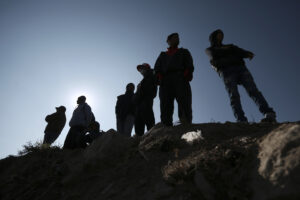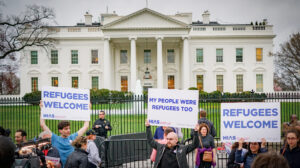Reform the Border Patrol Too
Immigration reform now seems certain to pass the Senate within days, in an amended bill that could win as many as 70 votes from both parties. The results will improve life for millions of undocumented workers and their families -- but the costs will not be negligible.
Immigration reform now seems certain to pass the Senate within days, in an amended bill that could win as many as 70 votes from both parties. The results will improve life for millions of undocumented workers and their families — but the costs will not be negligible, including a “surge” that will rapidly double the size of the U.S. Border Patrol to 40,00 agents, along with much more fencing and surveillance technology.
Those expensive “security enhancements” were included to satisfy or silence Republican complaints about the supposedly porous border, although that theme seemed to be more an excuse to oppose reform than a true issue. In fact, illegal border crossings have declined precipitously over the past few years while deportations have increased, and the number of arrests by the average Border Patrol agent has dropped from as many as 100 to only 19 annually.
So why do we need thousands of additional agents at the border? Evidently the manpower increase — along with the fencing and the high-tech surveillance gadgets that have never worked — is necessary so that legislators can proclaim their own toughness. But the consequences of swiftly bringing on such a huge influx of inexperienced personnel could prove deadly.
Over the past few years, Border Patrol agents have killed several innocent civilians in several incidents that suggest overzealousness and inadequate training. A federal grand jury is examining the terrible case of a Mexican man apparently murdered, as witnesses watched, by agents who beat him and shocked him repeatedly with Tasers while his hands were bound. The San Diego, Calif., Coroners Office classified his death as a homicide. At least eight others, only one with any connection to criminality, were killed in cross-border shootings that have understandably outraged the government and people of Mexico.
Journalist and filmmaker John Carlos Frey first exposed these lethal incidents — and the troubling disorder in the Border Patrol — with a series of prize-winning broadcasts and articles over the past year. In one such case, which Frey examined in the May issue of The Washington Monthly, Border Patrol agents responded to rocks thrown across the border with a volley of gunfire into the streets of Nogales, Mexico. Jose Antonio Elena Rodriguez, an unarmed young man strolling through the neighborhood, was hit twice in the back of the head and six times in the back. He fell and died on the spot.
In another case, Border Patrol agents killed a father of four while he was collecting firewood along the banks of the Rio Grande River. They also shot a 36-year-old man while he held a picnic to celebrate his daughter’s birthday, and a 15-year-old boy who was watching a Border Patrol agent apprehend a migrant.
These cross-border shootings and other instances of apparent brutality have failed to attract much international attention so far, according to Frey. But his own investigations have disclosed a portrait of “an agency operating with thousands of poorly trained rookies and failing to provide the kind of transparency, accountability and clear rules of engagement that Americans routinely expect of law enforcement agencies.”
As Frey notes, the Border Patrol not so long ago enjoyed a far better record and reputation. The rise in unjustified police violence along the Mexican border has coincided with a sharp increase in the number of agents, stemming from the Bush administration’s panicky reaction to a tide of illegal immigration between 2006 and 2009.
It is also true, he writes, that Border Patrol agents have a dangerous and difficult job. Since 2007, at least 20 agents have been killed in the line of duty, either accidentally or in violent encounters with smugglers. At least one was killed by friendly fire in a confrontation with suspected drug runners.
That is why Congress, the Department of Homeland Security and the president must ensure that every agent receives sufficient training to protect the border, themselves, and the innocent civilians of the United States and Mexico. There is no longer an immigration emergency, if there ever was one. So before rushing to bring on 20,000 more agents, U.S. authorities have to establish the rule of law, order, and justice within the Border Patrol itself. The alternative involves too much risk, at too much expense, for too little reason.
© 2013 CREATORS.COM
Your support matters…Independent journalism is under threat and overshadowed by heavily funded mainstream media.
You can help level the playing field. Become a member.
Your tax-deductible contribution keeps us digging beneath the headlines to give you thought-provoking, investigative reporting and analysis that unearths what's really happening- without compromise.
Give today to support our courageous, independent journalists.









You need to be a supporter to comment.
There are currently no responses to this article.
Be the first to respond.